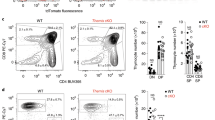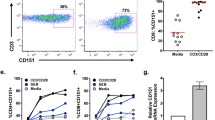Abstract
The T-cell-specific cell-surface receptors CD28 and CTLA-4 are important regulators of the immune system. CD28 potently enhances those T-cell functions that are essential for an effective antigen-specific immune response1,2,3,4,5, and the homologous CTLA-4 counterbalances the CD28-mediated signals and thus prevents an otherwise fatal overstimulation of the lymphoid system6,7,8,9. Here we report the identification of a third member of this family of molecules, inducible co-stimulator (ICOS), which is a homodimeric protein of relative molecular mass 55,000–60,000 (Mr 55K–60K). Matching CD28 in potency, ICOS enhances all basic T-cell responses to a foreign antigen, namely proliferation, secretion of lymphokines, upregulation of molecules that mediate cell–cell interaction, and effective help for antibody secretion by B cells. Unlike the constitutively expressed CD28, ICOS has to be de novo induced on the T-cell surface, does not upregulate the production of interleukin-2, but superinduces the synthesis of interleukin-10, a B-cell-differentiation factor. In vivo, ICOS is highly expressed on tonsillar T cells, which are closely associated with B cells in the apical light zone of germinal centres, the site of terminal B-cell maturation. Our results indicate that ICOS is another major regulator of the adaptive immune system.
This is a preview of subscription content, access via your institution
Access options
Subscribe to this journal
Receive 51 print issues and online access
$199.00 per year
only $3.90 per issue
Buy this article
- Purchase on Springer Link
- Instant access to full article PDF
Prices may be subject to local taxes which are calculated during checkout



Similar content being viewed by others
References
Hara, T., Fu, S. M. & Hansen, J. A. Human T cell activation. II. A new activation pathway used by a major T cell population via a disulfide-bonded dimer of a 44 kilodalton polypeptide (9.3 antigen). J. Exp. Med. 161, 1513–1524 (1985).
Shahinian, A. et al. Differential T cell costimulatory requirements in CD28-deficient mice. Science 261, 609–612 (1993).
Lucas, P. J., Negishi, I., Nakayama, K., Fields, L. E. & Loh, D. Y. Naive CD28-deficient T cells can initiate but not sustain an in vitro antigen-specific immune response. J. Immunol. 154, 5757–5768 (1995).
Lenschow, D. J., Walunas, T. L. & Bluestone, J. A. CD28/B7 system of T cell costimulation. Annu. Rev. Immunol. 14, 233–258 (1996).
Chambers, C. A. & Allison, J. P. Co-stimulation in T cell responses. Curr. Opin. Immunol. 9, 396–404 (1997).
Walunas, T. L. et al. CTLA-4 can function as a negative regulator of T cell activation. Immunity 1, 405–413 (1994).
Tivol, E. et al. Loss of CTLA-4 leads to massive lymphoproliferation and fatal multiorgan tissue destruction, revealing a critical negative regulatory role of CTLA-4. Immunity 3, 541–547 (1995).
Waterhouse, P. et al. Lymphoproliferative disorders with early lethality in mice deficient in Ctla-4. Science 270, 985–988 (1995).
Thompson, C. B. & Allison, J. P. The emerging role of CTLA-4 as an immune attenuator. Immunity 7, 445–450 (1997).
Brunet, J. F. et al. Anew member of the immunoglobulin superfamily — CTLA-4. Nature 328, 267–270 (1987).
Peach, R. J. et al. Complementarity determining region 1 (CDR1)- and CDR3-analogous regions in CTLA-4 and CD28 determine the binding to B7-1. J. Exp. Med. 180, 2049–2058 (1994).
Truneh, A. et al. Differential recognition by CD28 of its cognate counter receptors CD80 (B7.1) and B70 (B7.2): analysis by site directed mutagenesis. Mol. Immunol. 33, 321–334 (1996).
Nunes, J. et al. CD28 mAbs with distinct binding properties differ in their ability to induce T cell activation: analysis of early and late activation events. Int. Immunol. 5, 311–315 (1993).
Thompson, C. B. et al. CD28 activation pathway regulates the production of multiple T-cell-derived lymphokines/cytokines. Proc. Natl Acad. Sci. USA 86, 1333–1337 (1989).
Kroczek, R. A. et al. Defective expression of CD40 ligand on T cells causes “X-linked immunodeficiency with hyper-IgM (HIGM1)”. Immunol. Rev. 138, 39–59 (1994).
MacLennan, I. C. Germinal centers. Annu. Rev. Immunol. 12, 117–139 (1994).
Tsiagbe, V. K., Inghirami, G. & Thorbecke, G. J. The physiology of germinal centers. Crit. Rev. Immunol. 16, 381–421 (1996).
Krummel, M. F. & Allison, J. P. CTLA-4 engagement inhibits IL-2 accumulation and cell cycle progression upon activation of resting T cells. J. Exp. Med. 183, 2533–2540 (1996).
Walunas, T. L., Bakker, C. Y. & Bluestone, J. A. CTLA-4 ligation blocks CD28-dependent T cell activation. J. Exp. Med. 183, 2541–2550 (1996).
Nakanishi, K. et al. Both interleukin 2 and a second T cell-derived factor in EL-4 supernatant have activity as differentiation factors in IgM synthesis. J. Exp. Med. 160, 1605–1621 (1984).
Jung, L. K., Hara, T. & Fu, S. M. Detection and functional studies of p60-65 (Tac antigen) on activated human B cells. J. Exp. Med. 160, 1597–1602 (1984).
Rousset, F. et al. Interleukin 10 is a potent growth and differentiation factor for activated human B lymphocytes. Proc. Natl Acad. Sci. USA 89, 1890–1893 (1992).
Kindler, V. & Zubler, R. H. Memory, but not naive, peripheral blood B lymphocytes differentiate into Ig-secreting cells after CD40 ligation and costimulation with IL-4 and the differentiation factors IL-2, IL-10, and IL-3. J. Immunol. 159, 2085–2090 (1997).
Choe, J. & Choi, Y. S. IL-10 interrupts memory B cell expansion in the germinal center by inducing differentiation into plasma cells. Eur. J. Immunol. 28, 508–515 (1998).
Schneider, C., Newman, R. A., Sutherland, D. R., Asser, U. & Greaves, M. F. Aone-step purification of membrane proteins using a high efficiency immunomatrix. J. Biol. Chem. 257, 10766–10769 (1982).
Rosenfeld, J., Capdevielle, J., Guillemot, J. C. & Ferrara, P. In-gel digestion of proteins for internal sequence analysis after one- or two-dimensional gel electrophoresis. Anal. Biochem. 203, 173–179 (1992).
Jacobs, K. A. et al. The thermal stability of oligonucleotide duplexes is sequence independent in tetraalkylammonium salt solutions: application to identifying recombinant DNA clones. Nucleic Acids Res. 16, 4637–4650 (1988).
Aruffo, A. & Seed, B. Molecular cloning of a CD28 cDNA by a high-efficiency COS cell expression system. Proc. Natl Acad. Sci. USA 84, 8573–8577 (1987).
Williams, A. F. & Barclay, A. N. The immunoglobulin superfamily — domains for cell surface recognition. Annu. Rev. Immunol. 6, 381–405 (1988).
Cordell, J. L. et al. Immunoenzymatic labeling of monoclonal antibodies using immune complexes of alkaline phosphatase and monoclonal anti-alkaline phosphatase (APAAP complexes). J. Histochem. Cytochem. 32, 219–229 (1984).
Prediction of transmembrane helices in proteins [online] (cited 01 Dec. 98)〈www.cbs.dtu.dk/services/TMHMM-1.0/〉 ((1998)).
Acknowledgements
We thank J. Ledbetter for the gift of monoclonal antibody 9.3; J. Slupsky for critical reading of the manuscript; and K. Ranke for technical assistance.
Author information
Authors and Affiliations
Corresponding author
Rights and permissions
About this article
Cite this article
Hutloff, A., Dittrich, A., Beier, K. et al. ICOS is an inducible T-cell co-stimulator structurally and functionally related to CD28. Nature 397, 263–266 (1999). https://doi.org/10.1038/16717
Received:
Accepted:
Issue Date:
DOI: https://doi.org/10.1038/16717
This article is cited by
-
Inducing expression of ICOS-L by oncolytic adenovirus to enhance tumor-specific bi-specific antibody efficacy
Journal of Translational Medicine (2024)
-
Fcγ receptors and immunomodulatory antibodies in cancer
Nature Reviews Cancer (2024)
-
INDUCE-2: A Phase I/II, open-label, two-part study of feladilimab in combination with tremelimumab in patients with advanced solid tumors
Cancer Immunology, Immunotherapy (2024)
-
Pan-Cancer Analysis of the Prognostic and Immunological Role of TOMM40 to Identify Its Function in Breast Cancer
Biochemical Genetics (2024)
-
Costimulatory receptors in the channel catfish: CD28 family members and their ligands
Immunogenetics (2024)
Comments
By submitting a comment you agree to abide by our Terms and Community Guidelines. If you find something abusive or that does not comply with our terms or guidelines please flag it as inappropriate.



